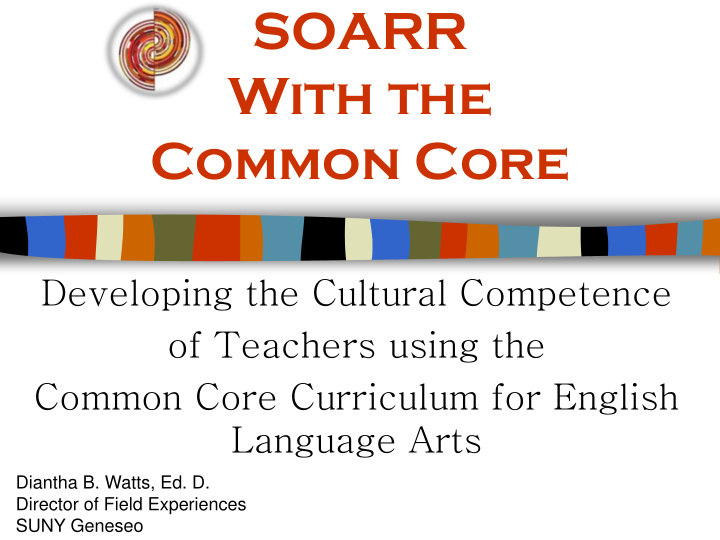



SOARR With the Common Core Developing the Cultural Competence of Teachers using the Common Core Curriculum for English Language Arts Diantha B. Watts, Ed. D. Director of Field Experiences SUNY Geneseo
Agenda Cultural Competence Cultural Competence for Teachers Cultural Competence and the Common Core Learning Standards SOARR Using the SOARR framework in teaching Resources
De Definition inition of of Cul ultural tural Com ompet petence ence Cultural competence is the ability to effectively work, i.e., teach, provide service, cross- culturally.” (Diller & Module, 2005)
Models dels of Cultural ultural Co Compete mpetence nce Origins of Cultural Competence : – Social Work (Cross, 1988) – Cross-Cultural Counseling (Petersen, Draguns, Lonner & Trimble, 1989) – Cross-Cultural Awareness Practice (Devore & Schlesinger, 1981; Green, 1982; Lum, 1986) – Intercultural Communication (Hoopes, 1972) – Multicultural Education (Banks & Banks, 1995)
Thr hree e CO MPONENTS of of COMPONENTS enc e Cul ultural tural Com ompet petenc Knowledge Awareness Skills
Cultural competence “A culturally competent teacher devises a curriculum that: enables students to view concepts, issues, events, and themes from the perspectives of diverse racial and cultural groups and/or leads students to make meaningful contributions to the resolution of social issues and problems . Teachers who add “multicultural fluff” do not meet the standard of multicultural education at a transformative level and may well decrease the ability of diverse students to interact effectively with the material (p. 161).” Diller & Moule (2005)
Common Core Goals “To understand other perspectives and cultures . Students appreciate the twenty-first century classroom and workplace are settings in which people from other widely divergent cultures and who represent diverse experiences and perspectives must learn and work together. Students actively seek to understand other perspectives and cultures through reading and listening, and they are able to communicate effectively with people of varied backgrounds.”
Cultural competence How do you incorporate cultural competence into everyday teaching? – Five concepts to remember for EVERY lesson you teach and EVERY interaction you have • S S elf-Awareness • O ther-Awareness • A ccepting multiple perspectives • R elevance • R eflection
SOARR S elf-Awareness O ther-Awareness A ccepting multiple perspective R elevancy R eflection
Self-Awareness Understand how the cultures of your communities impact you; Understand your cultural limitations; and Understand potential areas of tension and conflict. May include informal and formal Self-assessments National Center for Cultural Competence: http://nccc.georgetown.edu/foundations/assessment.html
Other Awareness What is your knowledge base about other groups? Is your knowledge of others limited or based on stereotypes? How are other groups portrayed in the material/subject area? Are other groups negatively represented in your teaching materials? Me, My Race & I http://www.pbs.org/race/005_MeMyRaceAndI/005_01-slideshow.htm
Acceptance/Awareness Of Multiple Perspectives Accepting differences as: – legitimate diverse realities – produce value Perspectives Toolkit (Teaching for Tolerance): http://www.tolerance.org/perspectives-toolkit
Relevance How can you make the material/lesson relevant to your students? – Think about the following • cultural backgrounds • ages • interests • skills needed to be successful (technology)
Reflection Consistent and persistent review of experiences, interactions and beliefs Noting changes, progress, conflating ideas, etc. May also include discussions with others
Common Core Opportunity “We see the Common Core as a powerful opportunity to build diversity into instruction and encourage powerful dialogue.” “They invite us to be culturally responsive in new ways.” Emily Chiarello (Teaching Tolerance, 2012)
Common Core Opportunity CCSS Global Compentencies : – Investigate the world – Recognize perspectives – Communicate ideas – Take action
Common Core Curriculum http://www.corestandards.org/assets/Appendix_B.pdf
Common Core Curriculum English Language Arts http://www.engageny.org/english-language-arts
Common Core Curriculum
Using the SOARR Framework CCLS Module 3.1 Guiding Questions: – What is the power of education and reading? – How does where people live in the world affect how they access reading and books?
Module 3.1
SOARR S elf-Awareness O ther-Awareness A ccepting multiple perspective R elevancy R eflection
Self-Awareness Teacher must consider her/his own beliefs about this topic – What do I truly believe about reading and writing? – What are my biases about access to reading and books? – Do I highly value books and reading in such a way that I believe that those who do not read and write are inferior? – Why do I feel this way? – Who/What has shaped these beliefs and values?
Other Awareness What are my beliefs about how others view reading and writing? How might my knowledge of others’ views of reading and writing be based on stereotypes? What do I know about others’ view of reading and writing? What more can I learn about others’ view of reading and writing?
Accepting Multiple Perspectives Do all cultures value reading and writing in the same way? In what ways do other cultures vary in their perspectives on books as well as traditional reading and writing? What barriers may exist that prevent this access to books, reading and writing?
Relevance How do I make this topic relevant for the students in my classroom and their families? How do my students truly feel about this topic? How can I find out about their beliefs? Do students have a more modern view (technology infused)? Why do they need to know this information?
Reflection Now that I have taught this lesson/module/unit, what did I learn about myself, others, and my students? How have my beliefs about this topic changed? How will I use this information to improve my understanding of others and myself? What other texts can be used to enhance this topic?
SOARR S elf-Awareness O ther-Awareness A ccepting multiple perspective R elevancy R eflection
Resources Diversity Toolkit: http://www.nea.org/tools/diversity-toolkit.html Me, My Race & I: http://www.pbs.org/race/005_MeMyRaceAndI/005_01-slideshow.htm Multicultural Education Resources: http://www.edchange.org/multicultural/case-studies.html The danger of a single story: http://www.ted.com/talks/chimamanda_adichie_the_danger_of_a_single_story Why Cultural Competence (NEA): http://www.nea.org/home/39783.htm Teaching Tolerance Anti-Bias Framework: http://www.tolerance.org/sites/default/files/general/TT%20anti%20bias%20frame work%20pamphlet_final.pdf Self-Assessment Tools: Implicit Attitude Test: https://implicit.harvard.edu/implicit Cultural Awareness Self-Assessment: http://highered.mcgraw-hill.com/sites/dl/free/0072563974/87090/ch02.html Perspective Tool Kit: http://www.tolerance.org/perspectives-toolkit
resources Texts: Cultural competence: A Primer for Educators (Diller & Moule) Building Racial and Cultural Competence in the Classroom (Teel & Obidah) Cultural Proficiency: A Manual for School Leaders (Lindsey, Robins & Terrell) Blink (Malcolm Gladwell)
Recommend
More recommend